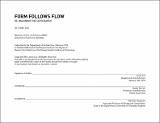Form follows flow : re-imagining the skyscraper
Author(s)
Lee, Juney, M. Arch. Massachusetts Institute of Technology
DownloadFull printable version (7.376Mb)
Other Contributors
Massachusetts Institute of Technology. Department of Architecture.
Advisor
Nader Tehrani.
Terms of use
Metadata
Show full item recordAbstract
Skyscraper is a by-product of 19th century American industrialism. spirit, and disaster. The Great Chicago Fire of 1871 was a catastrophe that necessitated dense and rapid reconstruction, both of which the high-rise provided. The accidental discovery of this new typology forever changed the contemporary urban habitat. Demand required density, which produced profit. Relentless pursuit of maximum mass and profit in 20th century New York City transformed the skyscraper into shameless public display of cash cows for the elitist few of the capitalist society. Enslaved by its financial incentives, the promise it once held was negated by repetitive banality. Today, starchitects are desperately prolonging the life of a typology that has not been invested with new thinking or ambition since its inception (Koolhaas, 2004). The intensification of density it initially delivered has been replaced by carefully-spaced isolation to maximize its visual superiority. Skylines of emerging civilizations have become test sites for celebrity architects to display their brands which are more Interested in its private agenda than greater public good. By 2050, 70% of the world's population will be living in urban areas (United Nations, n.d.). In 2012 alone, 66 buildings taller than 200 meters were constructed worldwide (CTBUH, 2013). In an age when explosive growth is not imminent, but inevitable, the developing societies continue to "adopt the skyscraper as the symbol of its modernity" (Koolhaas, 2004). Skyscraper is a critical architectural specimen that will not only symbolize that growth, but also accommodate and sustain it. The typology was born out of necessity. pushed to the limits through its financial objectives, and is now polluted with vanity of celebrity architecture. The objective of this thesis is not to design the "perfect" skyscraper: Rather, it challenges the century-old methods of envisioning and designing skyscrapers in order to resurrect its urban significance. The typology must be re-imagined in its totality through the fundamental understanding and re-investigation of the flow of elements that make the skyscraper possible.
Description
Thesis: M. Arch., Massachusetts Institute of Technology, Department of Architecture, 2014. This electronic version was submitted by the student author. The certified thesis is available in the Institute Archives and Special Collections. Cataloged from student-submitted PDF version of thesis. Includes bibliographical references (pages 108-109 ).
Date issued
2014Department
Massachusetts Institute of Technology. Department of ArchitecturePublisher
Massachusetts Institute of Technology
Keywords
Architecture.